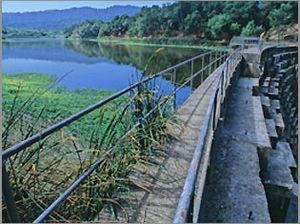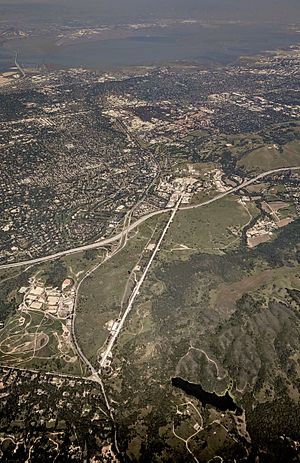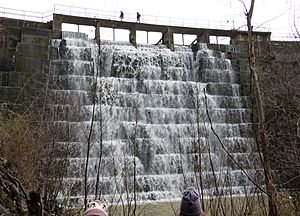Searsville Dam facts for kids
Quick facts for kids Searsville Dam |
|
|---|---|

Searsville Lake and dam around 2009 with heavy reservoir siltation visible
|
|
|
Location of Searsville Dam in USA California
|
|
| Location | San Mateo County, California, USA |
| Coordinates | 37°24′25″N 122°14′16″W / 37.40694°N 122.23778°W |
| Construction began | 1890 |
| Opening date | 1892 |
| Owner(s) | Stanford University |
| Dam and spillways | |
| Type of dam | Masonry |
| Impounds | Corte Madera Creek in the San Francisquito Creek watershed |
| Height | 65 ft (20 m) |
| Width (base) | 275 ft (84 m) |
| Spillway type | Service, stepped |
| Reservoir | |
| Creates | Searsville Lake |
The Searsville Dam is a large wall built across Corte Madera Creek in San Mateo County, California. It was finished in 1892, just one year after Stanford University was started. The dam holds back the creek's water to create a lake called Searsville Lake.
Searsville Dam is located inside the Jasper Ridge Biological Preserve. Stanford University owns and takes care of the dam. Nearby cities include Woodside and Portola Valley, California.
Contents
History of Searsville Dam
When the dam was built, it caused part of a small town called Searsville to be covered by water. This town and its hotel were founded in 1854 by John H. Sears. They were there to support the local logging industry.
The dam was first owned by the Spring Valley Water Company. In the big 1906 San Francisco earthquake, the dam got a small crack. It was only about the width of a finger, and it was quickly fixed.
What Searsville Dam Looks Like

The Searsville Dam is about 65-foot-tall (20 m) and 275-foot-wide (84 m). It is made of concrete blocks that look like a giant, steep staircase.
For 50 years, people could use Searsville Lake for fun activities. But in 1975, Stanford University stopped public access. They turned the area into a special nature preserve called the Jasper Ridge Biological Preserve.
Over time, a lot of dirt and sand (called sediment) has filled up the lake. Because of this, the lake has lost more than 90% of its original water storage space. Searsville Dam does not provide drinking water, help with floods, or create electricity.
Wildlife and the Dam
The dam creates a big problem for fish like salmon and steelhead trout that need to swim upstream to lay their eggs. These fish cannot get past the dam.
The San Francisquito Creek area is home to one of the most important groups of native steelhead trout in the South San Francisco Bay. These fish are also called coastal rainbow trout. Even though some steelhead trout still lay their eggs below the dam, they cannot swim above it anymore.
Long ago, Corte Madera Creek was known as a place where steelhead trout laid their eggs. However, some rainbow trout that live in the stream can still swim from Searsville Lake to lay their eggs in the upper parts of Corte Madera Creek. This helps these native fish survive above the dam.
A study in 2002 showed that Searsville Dam is the only complete barrier for fish trying to swim up San Francisquito Creek. If the dam were removed, it could open up ten miles of habitat for steelhead trout.
Coho Salmon in the Creek
There is good evidence that coho salmon used to live in San Francisquito Creek. Old records and stories from people who lived nearby suggest that coho salmon were common in the creek until the middle of the 1900s.
One person, Edgar H. Batchelder, whose father took care of the dam in 1897, remembered that when the dam overflowed in winter, salmon would swim up to the dam's base. His family would catch them for food. Another person remembered catching steelhead and coho salmon in the 1930s and 1940s. A third person recalled playing on San Francisquito Creek around 1947 and said, "Salmon swam up it, and in winter it was a dangerous place."
Native and Non-Native Fish
In 1996, scientists studied the upper part of Searsville Lake and Corte Madera Creek. They believed that native fish like coastal rainbow trout, sculpin, California roach, hitch, speckled dace, and Sacramento sucker used to live there. They also thought Pacific lamprey, three-spined stickleback, Sacramento pikeminnow, Sacramento blackfish, and coho salmon might have been present.
Today, the only native fish regularly seen are Sacramento suckers and rainbow trout. The scientists think this is because the dam changed the water flow. The area above the dam became more like a lake than a flowing stream. Also, Searsville Lake has many non-native fish like sunfish, black bass, and crappie. These non-native fish eat almost all the native fish.
The scientists also noted that federally threatened California red-legged frogs live in the flowing parts of Corte Madera Creek below the dam. But they are not found above the dam. This is probably because of the non-native fish and American bullfrogs that live in the lake.
In 2013, the pool below the dam was drained for a safety check. Scientists found two steelhead trout, 26 California roach, and 22 Sacramento suckers (all native fish). But they also found more than 1,500 non-native fish! These included over 500 sunfish (like green sunfish, bluegill, and redear sunfish), two bullhead catfish, and over 1,000 mosquitofish. They also found 500 bullfrogs and 150 Louisiana red swamp crayfish, which are also not native to the area.
Should the Dam Be Removed?
Some groups, including environmentalists and fishermen, believe the dam should be removed. They argue that removing the dam would help salmon and steelhead trout swim upstream to lay their eggs. They also say that the dam covered up important wetlands. These wetlands used to help clean the water in San Francisquito Creek. Supporters of dam removal point out that many dams across the country have been removed to help nature.
However, the Jasper Ridge Advisory Committee thinks removing the dam has many problems. They are not sure that removing the dam would definitely bring back steelhead trout. They also worry that it would destroy the homes of many birds and bats that live there now. Removing the dam and all the built-up dirt would be very difficult. It could also affect the communities and environment downstream. Stanford University also uses water from the lake to water its golf course and other sports areas on campus.




